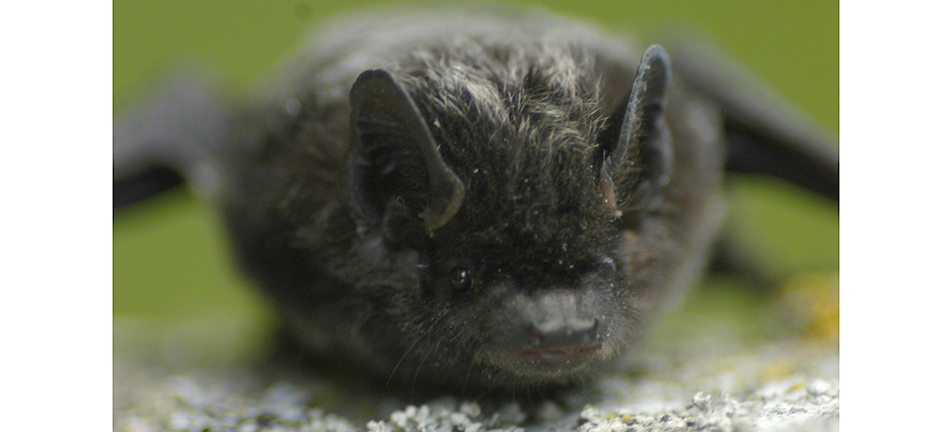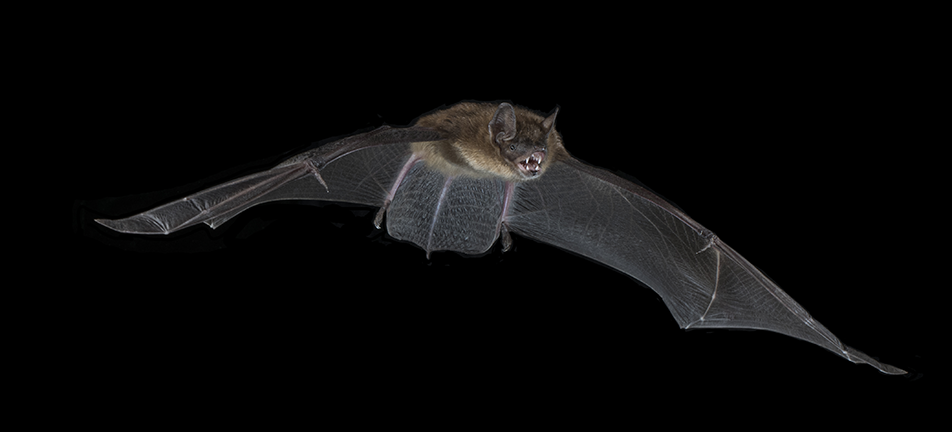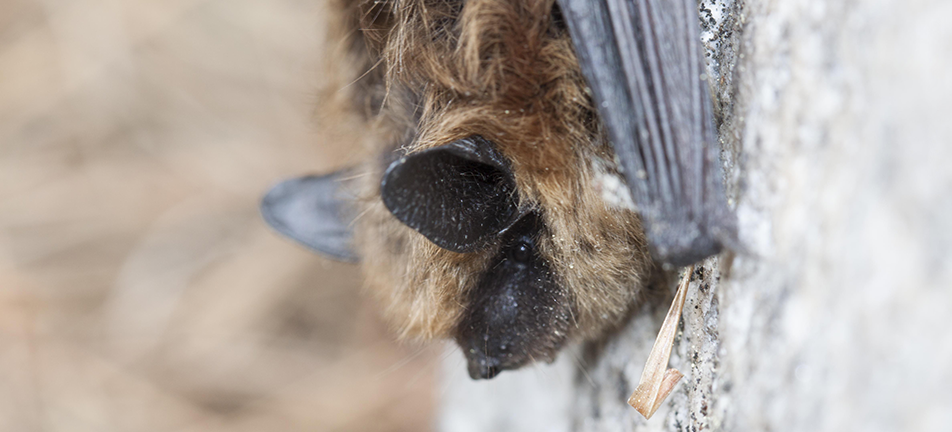 | Hoary bat | Eastern red bat | Silver-haired bat | Big brown bat | Tricolored bat | |
By Dan Schneider and Peter Pautler
As the only flying mammals in the world, bats can make an impressive claim to fame. Eight species of these nocturnal creatures live in Ontario. Agile and predatory, our bats are capable of extremely sophisticated bio-sonar, also called echolocation, meaning that they emit pulses of sound and can detect echoes bouncing back from objects, including their prey.
As insectivores, Ontario’s bats are beneficial to humans. A lactating little brown myotis bat needs to consume her full body weight in insects every night, equivalent to some 5,000 mosquitoes. By consuming myriad moths and other flying insects, bats help to protect us and agricultural fields from many pests. A recent study in the US estimated agricultural savings of 21.9 billion dollars.
Comparatively speaking, bat babies are giants. A newborn little brown bat weighs an astonishing 25 percent of its mother’s weight. In comparison, a human baby weighs about 6 percent of its mother’s weight. Offspring are born in late spring and early summer, in nursery colonies which are usually found in tree cavities, attics, tree branches or bat boxes.
Watching a bat’s acrobatic aerial maneuvering can be mesmerizing, but identifying them by species is challenging. Using a bat detector, which lowers frequencies to make bat calls audible to human ears, helps with identification, although it is not always definitive.
Five out of the eight species of bats found in Ontario hibernate in caves and mines over winter. These non-migratory species are the ones being affected by the devastating fungus (Pseudogymnoascus destructans) which causes white nose syndrome.
Read about white nose syndrome (WNS).
Hoary Bat
Status: Endangered provincially and nationally
Size: Ontario’s largest bat, but weighs less than a chipmunk.
Length: 10–15 centimetres (10–15 centimetres).
Wingspan: 34–42 centimetres.
Weight: 19–35 grams.


Description: White-tipped hairs give the appearance of hoarfrost contrasting with the grey body fur; yellowish or toffee coloured hair around throat and face; short and rounded ears black at the edges; tail membrane also furred on the dorsal side.
Habitat: In Ontario hoary bats are found in coniferous or deciduous forests along edge habitat. They roost near the tops of trees and forage in clearings near sources of water.
Range: A widespread species found throughout North America south to Chile and Argentina in South America and indigenous to Hawaii; in Ontario ranges north to the southern tip of James Bay.
Bat fact: To meet the needs of its nursing twins and its own energy requirements, a lactating female may hunt for up to six hours, which is 73 percent longer than its usual foraging time.

Eastern Red Bat

Status: Endangered provincially and nationally
Size: Medium-sized bat.
Length: 8.5–12.5 centimetres.
Wingspan: 28–33 centimetres.
Weight: 7–18 grams.
Description: A colourful species distinguished by its yellowish orange to red fur; on some individuals, white-tipped hairs result in a “frosted” appearance; males usually brighter than females; back of the small rounded ears, face and tail membrane covered in fur.


Habitat: In Ontario eastern red bats are found in coniferous and mixed forests. They prefer to roost at the top of trees suspended from branches.
Range: South, central eastern and western Ontario north to James Bay; from the Maritimes to Saskatchewan in Canada and into the eastern United States.
Bat fact: Like the two other migratory species in Ontario (hoary and silver-haired bats), eastern red bats seem less susceptible to WNS. This may result from being less gregarious, as they migrate south in late summer or early fall and roost in trees rather than congregating in cool, damp caves which favours the WNS fungus.
Silver-haired Bat

Status: Endangered provincially and nationally
Size: Medium-sized bat.
Length: 9–11.5 centimetres.
Wingspan: 26–31 centimetres.
Weight: 6–14 grams.
Description: Dark brown to black all over, except on dorsal side where white tipped hairs give a “frosted” appearance; tail membrane partly furred; ears short, naked and black.


Habitat: Forested areas adjacent to water for foraging. Silver-haired bats roost under loose tree bark alone or in small groups.
Range: Throughout southern and central Ontario and westward to Lake of the Woods; widespread throughout temperate regions of North America.
Bat fact: Field studies of silver-haired bats have revealed a geographical separation of the sexes — females, even when pregnant, migrate farther north while males remain in the vicinity of the Lower Great Lakes.
Big Brown Bat
Size: Medium-size bat.
Length: 9–13 centimetres.
Wingspan: 32–39 centimetres.
Weight: 11–26 grams.


Description: Long, sometimes wavy, dark brown fur evenly coloured across the back with lighter undersides; face, ears and wing membranes black and unfurred; ears short.
Habitat: Big brown bat habitat varies including wooded habitats near water and urban areas.
Range: Common and widespread; found in Ontario around the Great Lakes and west to Manitoba; also ranges over most of North American continent from Alaska to northern South America and into the Caribbean islands.
Bat fact: Big brown bats are a hardy species, arriving late at hibernation sites and preferring cooler and drier locations near the entrances of caves, mines and anthropogenic structures. In summer, big brown bats remain relatively close to their hibernating sites (within 50 kilometres).

Tricolored Bat

Status: Endangered provincially and nationally
Size: One of Ontario’s smallest bats.
Length: 7–10 centimetres.
Wingspan: 19–26 centimetres.
Weight: 5–8 grams.
Description: A drab golden to greyish brown appearance, but back hairs tri-coloured with dark brown at the base, yellowish brown in the midsection and dusky grey at the tips; ears, nose, wing and tail membranes dark brown, except contrasting reddish brown forearm.


Habitat: Near edges of forests. Tricolored bats roost in rock crevices, caves, buildings and tree foliage. Hibernate in caves or abandoned mines.
Range: Found in southern, central and eastern Ontario and may be locally abundant; North American range restricted to eastern Canada and United States south into Mexico
Bat fact: Eastern tricolored bats lose up to 30 percent of their body mass during hibernation between October and April. During spring and summer, they are efficient predators, catching an insect every two seconds and, in a mere 30 minutes, are able to increase their body mass by 25 percent.
Little Brown Myotis Bat
Status: Endangered provincially and nationally
Size: Small-sized bat.
Length: 6–10 centimetres.
Wingspan: 21–27 centimetres.
Weight: 5–14 grams.


Description: Glossy brown fur across the back, light fur chin to tail. Little brown myotis bats are a part of the difficult-to-identify Myotis complex. The complex comprises three species (eastern small-footed, northern long-eared myotis, little brown myotis bat). These species are not distinguishable using a bat detector, so they can only be identified by morphological characteristics. Distinguishing characteristics include shorter, thin rounded fleshy projection at opening of ears and several long hairs that extend from its feet to its claws.
Habitat: During the day little brown bats roost in trees and buildings. They often selects attics, abandoned buildings and barns for summer colonies where they can raise their young. Little brown myotis bats, big brown bats and tricolored bats are the only three species in Ontario that regularly make use of buildings for their maternity colonies.
Range: From southern Ontario, north to the tree line. Wide-spread in Canada and the United States, into Mexico.
Bat fact: Before the arrival of WNS, the opportunity for a long life seemed within reach of bat offspring who survived their first winter hibernation. An adult male little brown myotis bat, banded in southeastern Ontario, survived for a record 31 years.

Northern Long-eared Myotis

Status: Endangered provincially and nationally
Size: Small-sized bat.
Length: 7–10 centimetres.
Wingspan: 21–26 centimetres.
Weight: 6–9 grams.
Description: Dull yellow-brown fur with pale grey belly, long rounded ears. Similar to the little brown myotis bat, except fleshy portion covering ears is pointed and longer. Hibernates from October to March, mostly in caves or abandoned mines.


Habitat: Forests including boreal and mixed; northern long-eared myotis roost in buildings, under loose bark and in tree cavities. Hibernates from October to March, mostly in caves or abandoned mines.
Range: In Ontario, Northern myotis is found across the southern regions of the province and along the north shores of lakes Huron and Superior. There are also occasional records from further north, including one from Moosonee. Globally, they are found throughout Canadian provinces and territories and the mid and eastern states in the U.S.
Bat fact: Approximately 40 percent of the northern myotis’ global range is in Canada.
Eastern Small-footed Myotis
Status: Endangered provincially
Size: Smallest bat in Ontario.
Length: 7–9 centimetres.
Wingspan: 21–25 centimetres.
Weight: 3–7 grams.


Description: Yellowish brown to coppery brown over the back and top of head; buffy to pale grey underneath; black around the muzzle and eyes creates a “masked” appearance; ears, membranes of the tail and wings dark brown and naked.
Habitat: In spring and summer, small-footed myotis roost in a variety of habitats including rocks, rock outcrops, buildings, under bridges, in caves, mines or hollow trees. In winter, they hibernate in caves and abandoned mines in deciduous and mixed forest regions of Ontario and Quebec.
Range: In Ontario, spotty distribution south of Georgian Bay to Lake Erie and east to the Pembroke area with sightings in Espanola, Lake Superior Provincial Park and Bruce Peninsula. They have been found in the Appalachian region of the United States.
Bat fact: This species is susceptible to decline as forests are logged around hibernation and foraging areas. The survival rate for female eastern small-footed myotis bats appears to be substantially lower, at 42 percent, than that of males, at 76 percent. This difference may be due to the demands of reproduction, the need for females to remain active for longer periods each day, and to their having less time to accumulate sufficient body mass for hibernation. Small-footed bats are the rarest bat in Canada.


Efforts to help our bat species have never been more important. Some actions suggested by Bat Conservation International include:
- Avoid disturbing bats, especially in their hibernating caves
- Avoid spread of WNS by humans (disinfect caving clothes before entering a cave)
- Get involved in bat monitoring and protection (batwatch.ca)
- Provide homes for bats. (batcon.org/resources/getting-involved/bat-houses)
- In the Toronto area, you can get involved with bat research in High Park (highparknature.org/wiki/wiki.php?n=Mammals.Bats)
- In the Grand Bend area, you can get involved with Pinery Provincial Park’s bat research program (pinerypark.on.ca/bats-in-pinery/)
Learn and teach about bats. (Many nature clubs, organizations and parks run bat talks or outings.) More WNS information can be found at: whitenosesyndrome.org and www.cwhc-rcsf.ca/wns.php.

In Ontario, the Canadian Cooperative Wildlife Health Centre is working with the Ministry of Natural Resources to monitor spread and impact of WNS.
To report unusual bat activity or deaths, call one of the following:
- Canadian Cooperative Wildlife Health Centre (1-866-673-4781) or www.cwhc-rcsf.ca/wns.php
- Natural Resources Information Centre (1-800-667-4781) or (1-866-686-6072 for hearing impaired)
Contributor: Noah Cole





- Species at risk in Ontario
- Bats Affected by WNS, White-Nose Syndrome Response Team webpage
- Bat White Nose Syndrome, Canadian Wildlife Heath Cooperative – Réseau canadien pour la santé de la faune webpage
- Bat Conservation International
- The Mine in My Life, BATS Magazine/Brock Fenton article
- Bats: A Conservation Guide, The Toronto Zoo



Please send information about bat population, moving away or hibernation places and schedules of bats in Ontario and Canada.
Good information about bats but does not tell about schedule of hibernation and places of travel during winter
I have 1 – 2 little brown bats in my loft. They can stay the winter but in the spring I will put out some bat boxes and make them unwelcome.
Any suggestions?
Hi Scott,
Thank you for being interested to set up bat boxes and for hosting little brown bats in your loft!
Here is a wonderful blog on the subject that might also help you connect with other bat study experts. https://ontarionature.org/canadian-bat-box-project/
One note is that “Under the ESA, it is prohibited to wilfully kill, injure OR interfere with an endangered species, or to interfere with or destroy the habitat of an endangered species. Note that the habitat of an endangered species is also protected!” So that, I don’t believe it is legal to interfere with the selected location or presence of little brown bats – meaning I don’t think you can shuffle them out or block their entrance. Though bat boxes would also help for external roosting sites.
I will check with conservation staff and can further follow up.
Noah
This is such great information! Thank you for this article. The clear pictures of each bat species are extremely helpful in their identification.
#Charlie@Integritywildlife.com
There is a dark brown bat roosting in a crevice outside my brick condo building in downtown Toronto, around 4 feet from the ground. It has been there for at least 3 days, maybe more (I only walked by there the other day), and doesn’t seem to have moved for the last 2 days. It’s fur was a nice light brown on the first day but now is rough dark brown with grey tips (a different bat?). I’ve left it alone, but am wondering if it’s still alive, as I assumed it would have flown off at night to feed. Is it possible it could have done so and returned to the exact same spot on a huge building? What should I do if it stays in the same place for more days? I’d like to call someone to remove it, but can’t find anyone in Toronto.
Hello Deborah,
Thank you for letting us know.
If you happen to see bats roosting on your building again, you could report unusual bat activity or deaths, to the Canadian Cooperative Wildlife Health Centre on-nu@cwhc-rcsf.ca or 1-866-673-4781 .
Noah C.
Hello!
We have a colony of bats living at the front of our house behind the fascia at the peak of the front gable. They seem to be there every year and we count 17 or 18 of them as of this evening as they headed out for dinner 🙂
We like them and aren’t interested in moving them but would love to get more info, identify what kind of bats they are etc. Are there any resources for gathering that kind of information? Happy to support any ongoing research or studies 🙂
I just discovered your website and I found this information very interesting and helpful. I believe there are bats roosting in my attic that managed to make their way inside the cottage over the past two winters.
I had hoped to prevent them from doing so again this winter. I’m pretty sure I found the location where they were getting into the attic so I installed a bat valve the other day. But now that I’m reading this, I think it is much too late in the season to do this as they might not have time to find a new place to roost for the winter. I don’t mind them being in the attic, I just don’t want them inside my building and I don’t know how they’re getting inside.
Any suggestions?
Hi Kirsten,
Thanks for asking.
We found this resource through the Ministry of Natural Resources that includes a timeline and appropriate exclusions that may be helpful. In short, it says that it is okay to install/use the one-way doors until end of November or so., but do not actively evict bats or restrict access Dec to March.
https://files.ontario.ca/environment-and-energy/species-at-risk/mnr_sar_tx_bat_exclu_enfr.pdf
With thanks and regards,
Noah
Hi Amanda,
Thanks a lot for asking that!
We’re glad you have discovered our Bat Guide, it has helpful resources to further learn from.
The Toronto zoo has a very good resource too: https://www.torontozoo.com/bats/meet
Best regards,
Noah